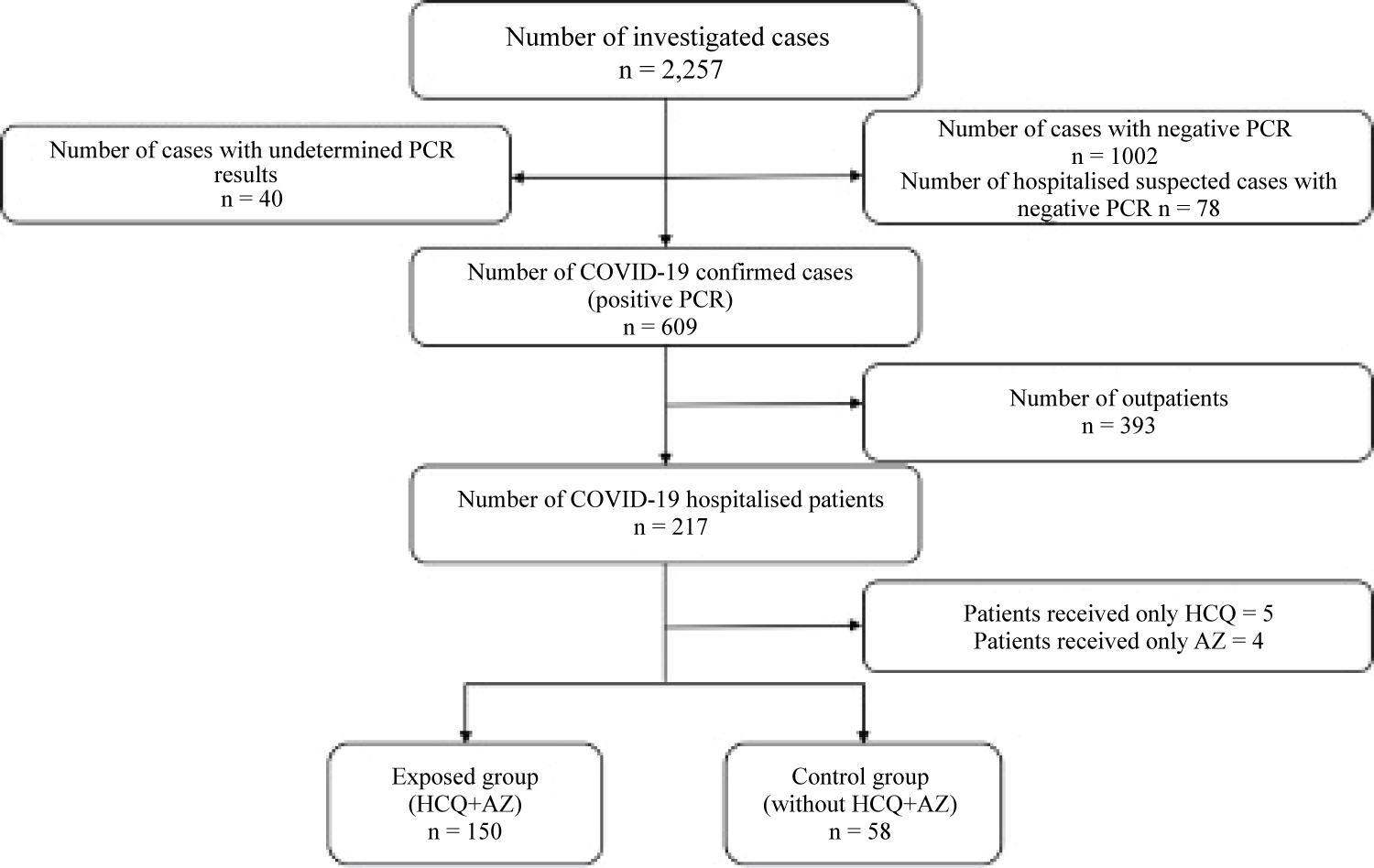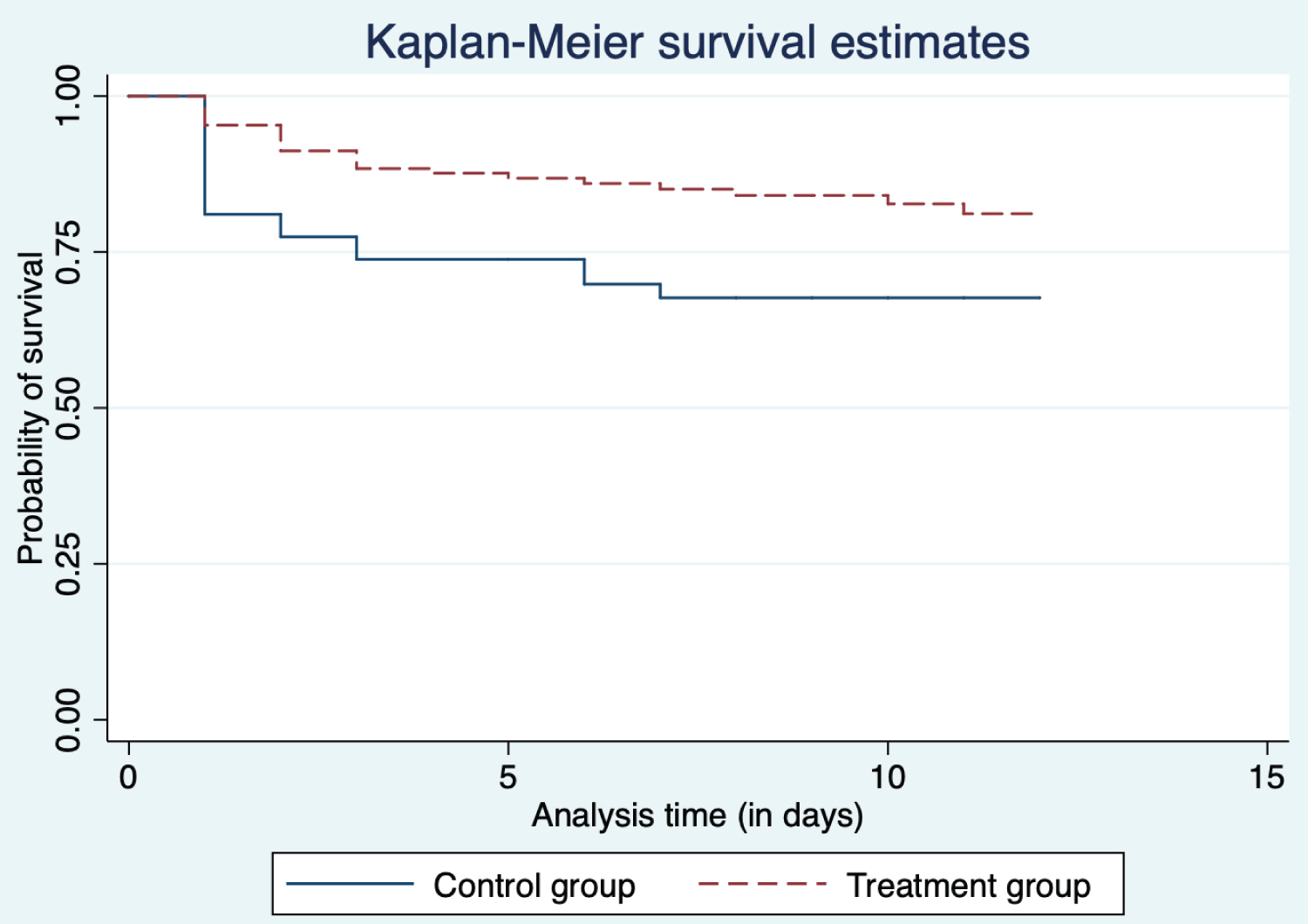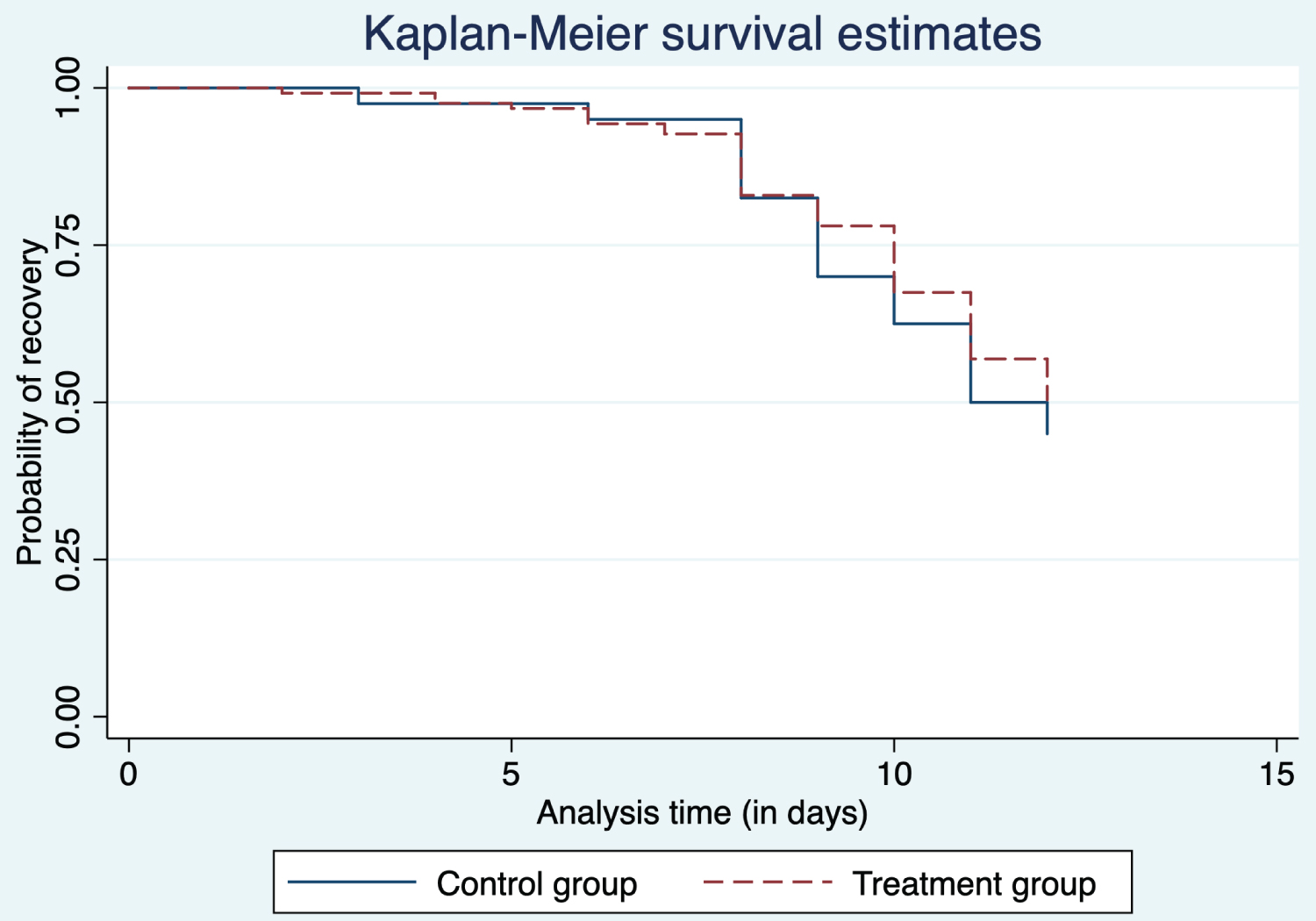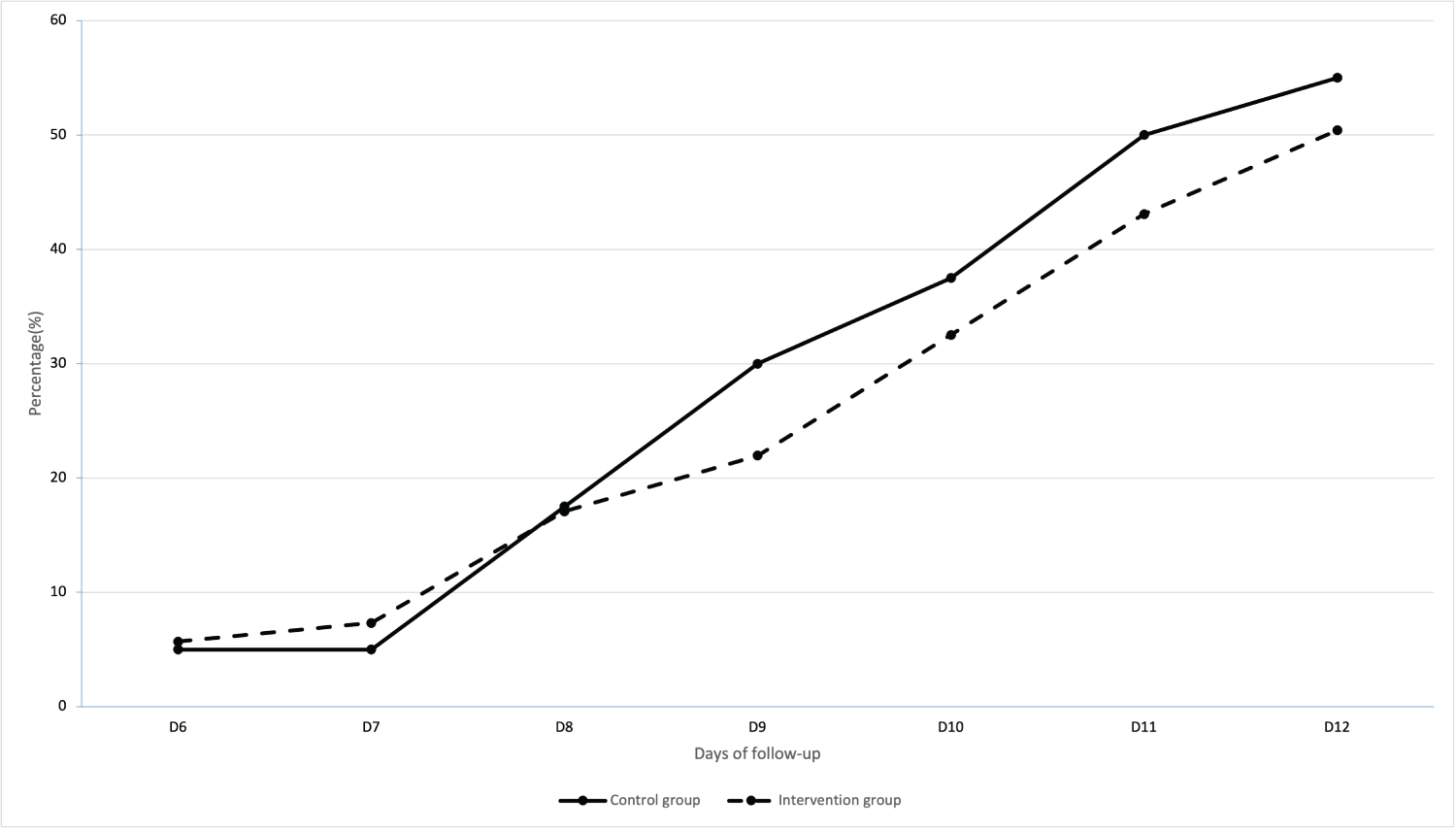Many countries have adopted hydroxychloroquine (HCQ) or chloroquine (CQ) and azithromycin (AZ) for the treatment of COVID-19 patients at the beginning of the pandemic and are still using them. The objective of this study was to measure the efficacy of CQ or HCQ and combined with AZ on patients' survival and recovery in Burkina Faso, West Africa.
We conducted a hospital-based retrospective cohort study using routine data from all the hospitals involved in the COVID-19 response in Burkina Faso. All patients treated before March 26, who did not receive the combination constituted the control group and those treated from March 26 to April 23, received CQ or HCQ, combined with AZ and constituted the treatment group. We estimated the mortality and recovery rate, and the treatment effect at day-12 with adjusted hazard ratios (aHR) along with their 95% confidence interval (CI) using Cox's proportional hazard regression models.
A total of 150 and 58 patients were included in the treatment and control groups, respectively. The mortality rates at day-12 were 18% in the treatment group versus 31% in the control group and were significantly different (HR = 0.47; 95%CI = [0.25-0.86]). After adjustment, we found no difference between treatment and control groups (aHR = 0.56, 95%CI = [0.27-1.19]). The recovery rates were 64.2% and 60% in the treatment and control group respectively but were not statistically different (HR = 1.08; 95%IC = [0.67-1.74]).
The treatment with CQ or HCQ combined with AZ had no independent effect on in-hospital COVID-19 mortality and recovery rate in Burkina Faso.
Chloroquine, Hydroxychloroquine, Azithromycin, Mortality, Recovery, Burkina Faso
The COVID-19 pandemic has resulted in more than 6 million cases of infection and claimed nearly 400,000 lives worldwide [1]. Besides, the pandemic has brought the global economy to an unprecedented stop and confined more than half of the world's population. While experts and governments implement lockdowns, hygiene, and physical distancing, scientists had to find a vaccine and treatment to reverse the trend.
Concerning the treatment, researchers around the globe have tested several drugs, including antiviral drugs [2], Chloroquine (CQ) and hydroxychloroquine (HCQ) [3-5], Azithromycin (AZ) [3], and Ivermectin [6] among others. These drugs are being tested either in combination or monotherapy. But the main controversy lies on whether or not CQ and HCQ in combination with AZ or alone are effective as a treatment for COVID-19. In West Africa, these drugs have been widely used to treat malaria before the emergence of resistance and their replacement by Artemisinin-based Combination Therapy (ACT).
Previous authors have reported the activity of CQ and HCQ on SARS-CoV-2 replication in vitro [7,8] and suggested a trial to evaluate its efficacy in vivo [9]. Thus, an observational study conducted [4] in France reported that HCQ was effective. According to the authors, the combination with AZ improved the efficacy [3,4]. However, several questions remain about HCQ or CQ effectiveness combined with AZ, and the relationship between the dosage and patient's safety. In the current literature, the studies have reported conflicting results, and these drugs appear to have no therapeutic effect on COVID-19 patients [10-13].
In March 2020, many countries, including Burkina Faso, have adopted the protocol with CQ or HCQ + AZ to treat COVID-19 patients. But there was no evidence on the effectiveness of these drugs. What was known for a fact was that studies report the efficacy of this combination with less robust and more questionable methodological approaches [3,4]. A randomised controlled trial conducted in China found that the administration of HCQ to mild to moderate COVID-19 patients does not increase the probability of negative conversion in the treatment group [11]. Then, the Recovery trial conducted in the United Kingdom also reported that Hydroxychloroquine was not effective [14]. Similar results have also been reported by a systematic review by Hong, et al. [15]. Some authors even raised concerns about the risk of increased mortality [16,17] and adverse effects of the combination [18].
This study explored the efficacy of CQ and HCQ in West African. There has been a tentative study, which was finally retracted [19]. Sub-Saharan Africa has widely used CQ and HCQ for decades, and malaria is still highly prevalent in the region. We believe that additional data from SSA will help bring more clarity on the efficacy of these drugs in treating COVID-19 patients. Therefore, we wish to share the results of the analysis of a cohort study. The objective was to measure the effect of CQ or HCQ, and AZ combined on COVID-19 patients' mortality and recovery rate at day 12 in Burkina Faso, West Africa.
We conducted a hospital-based retrospective cohort study with two groups. The first was composed of patients who received CQ or HCQ + AZ (treatment group) on admission, and the second was composed of those who did not receive CQ or HCQ + AZ during their hospital stay (control group). In Burkina Faso, during the first two weeks of the pandemic, all COVID-19 patients did not receive the treatment. The Ministry of Health in Burkina Faso issued a guideline on March 26, 2020, in which it instituted CQ or HCQ in combination with AZ as the standard treatment for all cases of COVID-19. All patients admitted after the guideline issuance and received the treatment were considered in the treatment group. None of the patients refused the treatment or showed a contraindication. The treatment started upon admission to the hospital for all patients in this group. Those who were admitted before the protocol constituted the control group.
At the start of the pandemic, only cases with risk factors or comorbidities or severity were hospitalised. The response team then decided to hospitalise all patients, although that has not always been the case. As a result, even some mild cases were hospitalised and therefore analysed.
We reviewed hospitals records and used routine data to assess the efficacy of the treatment. We included all the hospitals designated by the Ministry of Health (MoH) to manage COVID-19 cases in the country. There were three (03) of them: Tengandogo University Teaching Hospital (TUTH), Princess Sarah clinic in Ouagadougou, and Souro Sanou University Teaching Hospital (SSUTH) in Bobo-dioulasso.
In Burkina Faso, COVID-19 patients' data are centralised in four databases, each hospital having its own, and a central database at the MoH that contains all surveillance and patient management data. For this analysis, we triangulated across all these databases and reviewed patients' records to complete our dataset as much as possible.
Patients were eligible if they were aged 18 years or above, had tested positive for SARS-CoV-2 by Reverse Transcription Polymerase Chain Reaction (RT-PCR), and were admitted to one of the three hospitals between March 9 and April 23, 2020. Patients who received only CQ or HCQ or AZ alone were excluded from the analysis.
We compared two groups: Treatment and control. The treatment recommended by the MoH includes supportive care and 200 mg of HCQ or CQ every eight hours for ten days plus 500 mg of AZ the first day, followed by 250 mg per day from the second to the fifth day for uncomplicated cases with no risk factor. In the presence of a complication or a risk factor, 2g of ceftriaxone per day was added if necessary, and oxygen therapy was recommended for saturation below 90%. Complicated cases were those with abnormalities of vital parameters (respiratory rate > 30 per minute, systolic blood pressure less than 90 mmHg or a diastolic blood pressure less than 60 mmHg) or age greater than 65 years or the presence of one of the following comorbidities: diabetes, hypertension, sickle cell, asthma, cardiovascular disease, renal failure, chronic respiratory failure, HIV, malnutrition, etc. The guideline was implemented in the three hospitals as of March 26, 2020. Before that, patients (control group) received only supportive care, which included fever, cough, pain, and other symptoms management, and Vitamin C according to their symptoms. Patients in the intervention group also received this supportive care in addition to the treatment.
In terms of safety, for instance, HCQ and CQ are known to cause retinopathy and cardiovascular complications such as QT prolongation and ventricular tachyarrhythmia with low risk at the recommended doses (less than 5 mg/kg per day for HCQ and 3 mg/kg per day for CQ) [20,21]. However, the doses used in the treatment of COVID-19 are at least twice the recommended doses, increasing the incidence of adverse effects, particularly in combination with AZ. Previous studies reported that the QT interval increases by 6.1 ms after a dose of 600 mg and 28 ms after 1200 mg [22,23].
The follow-up started on admission, which was also the start of the treatment. All patients were followed up from admission until death, recovery, or twelfth day after admission, whichever occurred first.
The events of interest were death and recovery. The primary outcomes were the survival time and time to recovery at day-12. We chose these endpoints because, in practice, care providers in the three hospitals performed the first control test on day 6. This test was repeated on days 9 and 12 if the patient was still positive. Hence, secondary outcomes were survival and recovery time at day-6.
In this study, recovery was defined as a negative test for SARS-CoV-2 for a patient initially tested positive and hospitalised. The first negative test date was considered as the date of recovery for the computation of time to recovery variable.
We used numerous factors to adjust the effect of the treatment. These variables included patient's age and sex, time from symptoms onset to admission, clinical characteristics such as pre-existing conditions (hypertension, diabetes, chronic lung disease, liver diseases, renal failure, HIV and heart disease), temperature, blood pressure, heart rate and oxygen saturation (a proxy of severity). These variables were measured on admission.
Qualitative and quantitative variables were described with proportions and median along with interquartile range (IQR), respectively. We performed a bivariate analysis using the Chi-square test for proportion and median test for continuous variables. We used the Kaplan-Meier method to describe the survival function and "stph test" in Stata to check the hazard proportionality assumption.
The treatment effect on survival or recovery time was estimated using a multivariate Cox's proportional hazard regression model. We calculated unadjusted and adjusted hazard ratio (HR) and their 95% confidence intervals for mortality and recovery at days 6 and 12. For the estimation of the HRs associated with recovery, we used death as a competing risk. All analyses were performed on an intention-to-treat basis, with the null hypothesis that there was no treatment effect.
In the sensitivity analysis, we excluded all deaths within the first 24 hours after the admission and estimated the adjusted HRs. The same process was then performed with a propensity score matching of controls to the best match in the treatment group using the "psmatch2" command in Stata.
Data were extracted from the central District Health Information Software 2 (DHIS2) database of the MoH and completed with hospitals records. Data processing and analysis were performed using Stata 15 (StataCorp. 2017. Stata Statistical Software: Release 15. College Station, TX: StataCorp LLC).
There was no interaction with the patients. All the data were handled and kept confidential. The protocol was submitted and approved by the National Health Research Ethics Committee (approval number: 2020-5-096, on May 16, 2020) before the analysis.
Between March 9, when the first cases were notified in Burkina Faso, and April 23, 2020, the COVID-19 response team investigated 2257 suspected cases. Among them, 609 people were confirmed cases. Three hundred and ninety-three were managed at home, and 217 were admitted in the three hospitals. We excluded nine (9) patients from the analysis because they only received either HCQ or AZ alone. Our total analysis sample was composed of 208 patients, including 150 (72.1%) in the treatment and 58 (27.9%) in the control group (Figure 1).
 Figure 1: Flowchart of COVID 19 patients.
View Figure 1
Figure 1: Flowchart of COVID 19 patients.
View Figure 1
Data presented in Table 1 show the distribution of patients' sociodemographic and clinical characteristics at baseline. The participants had similar characteristics and were comparable at baseline except for cough (65.3% in treatment and 41.4% in the control group, p = 0.002) and hypertension (30% in treatment and 15.5% in control, p = 0.033).
Table 1: Baseline characteristics of patients with COVID-19 in treatment (hydroxychloroquine and azithromycin combined) and control group (no hydroxychloroquine + azithromycin). View Table 1
The age distribution was similar across the groups: 23.3% (n = 35) and 20.7% (n = 12) of the participants were aged 65 years or above in the treatment and control group, respectively (p = 0.739). Women represented 42% (n = 63) and 36.2% (n = 21) of the treatment and control group respectively (p = 0.445). The median oxygen saturation level was 95% in both groups (p = 0.279), and the median time from symptoms onset to admission was 8 (6-13) and 7 (4-10.5) days (p = 0.076) in treatment and control groups, respectively (Table 1).
There was no lost to follow-up. At day-12, the mortality rates were 18% in the treatment group versus 31% in the control group (Figure 2).
 Figure 2: Kaplan Meier curve for treatment and control group at day12.
View Figure 2
Figure 2: Kaplan Meier curve for treatment and control group at day12.
View Figure 2
These rates were significantly different in the bi-variate analysis (HR = 0.47; 95%CI = [0.25-0.86]). However, after adjustment on patient's age, sex, time from symptoms onset to admission, hypertension, and oxygen saturation, we found no association between the treatment and the risk of death (aHR = 0.57; 95%CI = [0.27-1.19]) (Table 2).
Table 2: Effect of treatment on mortality and recovery at day 6 and 12. View Table 2
Overall, 63% of the patient recovered by day-12. The rates were 64.2% and 60% in the treatment and control groups, respectively. Figure 3 shows the survival function of time to recovery, and Figure 4 shows the percentage of those who recovered from days 6 to 12. There was no significant difference between the two groups in the bi-variate analysis (HR = 1.08; 95%IC = [0.67-1.74]) nor in the adjusted model (aHR = 0.97; 95%CI = [0.58-1.61]) (Table 2).
 Figure 3: Kaplan Meier curve and hazard curve for treated and untreated group.
View Figure 3
Figure 3: Kaplan Meier curve and hazard curve for treated and untreated group.
View Figure 3
 Figure 4: Recovery rate per day.
View Figure 4
Figure 4: Recovery rate per day.
View Figure 4
In the additional analysis, we excluded all deaths within the first 24 hours after admission (2 in the treatment group and 7 in control) and re-estimated the aHRs. Although the survival curves of treated and untreated depart (S1 Appendix), this difference was not statistically significant. The risk of death at day-12 was still not associated with the treatment in the bi-variate analysis (HR = 0.66; 95%CI = [0.32-1.36]) nor in the adjusted model (aHR = 0.51; 95%CI = [0.23-1.12]) (S2 Appendix). Likewise, the time to recovery at day-12 was not statistically different across the groups in both the bivariate analysis (HR = 0.85; 95%CI = [0.52-1.39]) and the adjusted model (aHR = 0.82; 95%CI = [0.48-1.40]) as shown in S2 Appendix. Data presented in S3 Appendix show that the propensity score matching (PSM) did not significantly change these results. We performed PSM with 94 patients, 47 in each of the treatment and control groups, as shown in the S4 Appendix. S5 Appendix presents the curves of the probability of survival in the treatment and control group.
At day-6 of follow-up, 13.3% died in the treatment group and 29.3% in the control. The treatment was associated with a decreased risk of death in the bivariate analysis (HR = 0.42; 95%CI = [0.22-0.81]). But after adjustment, the risk of death was no longer statistically different across the groups (aHR = 0.60; 95%IC = [0.27-1.32]). Likewise, the treatment was not associated with the recovery in the bi-variate analysis (HR = 1.54; 95%CI = [0.17-13.83]) nor in the adjusted model (aHR = 1.23; 95%CI = [0.09-16.91]) (Table 2).
This study showed that CQ or HCQ + AZ as a treatment for COVID-19 was not independently associated with a decreased risk of in-hospital mortality or an increased recovery rate. After adjustment, neither the risk of death nor the recovery rate was statistically different across treatment and control groups.
This study is among the first to report on the efficacy of CQ or HCQ in West Africa. It was conducted in Burkina Faso, a country with less than 1000 cases of COVID-19 during the study period. But the proportion of deaths was above 6%. Other studies on HCQ have been conducted in Asia [11], Europe [3,4,10], or the United States [17,24]. The results of the Recovery trial are also available [14]. Although SSA countries have used chloroquine for decades and still have a high prevalence of malaria, they are not represented among the participants of the assessment of the efficacy of the drug. Our analysis adds on the growing evidence of the ineffectiveness of CQ or HCQ + AZ as a treatment for COVID-19, even in settings where the drug used to be utilised at a large scale. We were able to adjust our estimates with the main factors involved in COVID-19 patients' mortality (comorbidity, age, sex, time from symptoms onset to admission, and oxygen saturation) [25-28] and our findings are similar to those reported elsewhere in previous studies [11,12,24,29] including a large European trial [14]. They do not support the use of HCQ or CQ for the treatment of COVID-19. They also drew healthcare providers' attention on the treatment of patients with concurrent malaria because combining ACTs or another antimalarial drug with CQ or HCQ may be harmful.
In several countries, healthcare providers and policymakers adopted CQ and HCQ after the controversy arose after the early studies, which showed a beneficial effect on patients' survival and viral load clearance [3,4]. This approach could be understood and explained in a sense that CQ, which has shown in vitro activity on SARS-CoV-2 [7,8], could have offered hope in the absence of a proven effective treatment. But the scientific community continued to provide more evidence on the drug indication in COVID-19. Thus, after the first studies suggesting the efficacy of HCQ [3,4], few other authors have reported similar results [30], and later, several studies converged in the sense that this drug does not improve the health of COVID-19 patients [10,11,24] and could even be harmful [16,17].
In general, studies have considered various endpoints (clearance of viral load at day-6, the need for oxygen therapy or intensive care unit admission at day-8, contagiousness at day-8 and length of stay after three days of treatment) and doses [31], and often different methodological approaches [3,4,24]. The first studies conducted in France that suggested a beneficial effect of HCQ treatment analysed a relatively small sample size, in observational studies without a comparison group or with a control group made of patients from another hospital or refused the treatment [3]. Beyond the small sample size and the absence of a control group, the variety of endpoints does not allow the comparability. Besides, some endpoints may not adequately reflect the effectiveness of treatment of a disease for which, even without treatment, the majority of patients tend to recover spontaneously [32,33].
We could not find any beneficial effect of the combination. Therefore, we cannot recommend its use as a COVID-19 treatment. The Recovery trial [14] and a systematic review with meta-analysis by Hong, et al. [15] reached the same conclusion. Based on the evidence currently available, the treatment of COVID-19 patients should be based on the WHO recommendations [34].
Burkina Faso has adopted CQ/HCQ + AZ as the main drug for the management of all COVID-19 patients. As a result, we could not get more patients in the control group. Also, the groups were not followed up concurrently. The cohort of the control group started before the treatment group. Based on their experience in managing patients over time, care providers in particular and the national response in general may have improved their practices and, therefore, could have had better results in averting avoidable deaths in the second group (treatment). But this bias should result in better outcomes in the treatment group and overestimate the treatment beneficial effect. Likewise, the fact that we did not blind the analysis process could also have biased the estimates. Lastly, we could not consider some biological markers such as creatinine level, C-Reactive Protein (CRP), and lymphocyte count for the adjustment because of the missing data. Nevertheless, our findings are consistent with the strongest evidence currently available.
As most COVID-19 patients tend to recover, even without etiological treatment, a higher survival rate or faster clearance in the treatment group cannot necessarily be attributed to the treatment unless it is compared with a rigorously and well-designed control group. CQ or HCQ combined with AZ had no independent beneficial effect on COVID-19 patients' in-hospital mortality in Burkina Faso. It does not increase their recovery rate either. Although this drug has raised hopes for the management of the disease, it does not seem to have the expected beneficial effect. Our findings suggest that the treatment of COVID-19 patients should be based on the WHO recommendations.
AB, SK, and AKS designed the study; KC performed data processing; KC, AB, AP, and SK performed data analysis and interpreted the results; AB proposed the first draft; all other authors (AB, AP, KC, AKS, BO, ARO, ABT, PK, BWB, JZ, AS, SF, FK, AS, SK) contributed to the interpretation of the results, reviewed the manuscript and approved the final draft.
None declared.
This study conformed to ethical guidelines. The protocol was submitted and approved by the Burkina Faso National Ethics Committee for Health Research.
No fund received for this study.
The data available on request to Seni Kouanda, senikouanda@gmail.com
Abraham Bagbila, Adama Baguiya, Adama Sanou, Adama Sourabié, Alfred Tiono, Alphonse Ouédraogo, Amed Héma, Apoline Sondo, Armel Poda, Arouna Gnamou, Bertrand Meda, Boukary Ouedraogo, Brice Bicaba, Christian Minougou, Eric Diendéré, Fatimata Diallo, Flavien Kaboré, Honoré Samba, Ibrahim Traoré, Ismaël Guibla, Jacques Zoungrana, Jean Baptiste Tougouma, Kadari Cissé, Lakinapina Drabo, Mahamadi Tassembedo, Marcel Kuiré, Noelie Zoungrana, Patricia Ouedraogo, Pierre Kaboré, Risgou Ouédraogo, Rodrigue Diao, Seni Kouanda, Souleymane Fofana, Seidou Zida, Soumaila Traore, Thierry Ouattara.